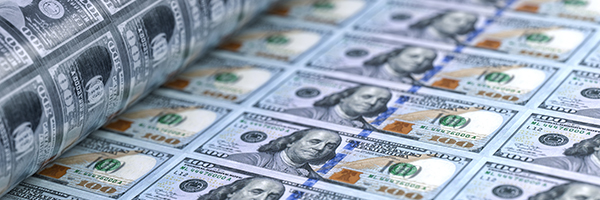
January 8, 2025 | AAPL, ACAD, ADSK, AGN, ALB, ALV, AMZN, ARCO, ARGT, AUY, BABA, BG, BGC, BHP, BMY, CHK, CMI, CNI, COH, CSCO, CTRP, CX, DD, DE, DHR, DWDP, DXJR, EBAY, EEM, EFNL, ENB, EUM, EWZS, FANG, FANUY, FB, FCX, FEZ, FLR, FLS, FTV, GDXJ, GE, GGAL, GLD, GLW, GOOG, HAIN, HDB, HP, INCY, ING, IONS, ITUB, IVV, JCI, JO, JOY, KBWB, KMI, LFL, LNG, LUX, MGM, MIDD, MON, Morning Briefing, MPC, MXF, NJDCY, NKTR, Notes You Need, OGXI, OKS, PEP, PFXF, POT, PXD, PYPL, QCOM, RSPP, RYN, SDRL, SFTBY, SH, Short Term, SLB, SPWR, SQM, STO, SYNA, TCEHY, TPR, TRGP, TS, V, VALE, VEA, Videos, VMC, VZ, WBK, WES, XOM, XYL, YPF, Z-SYMBOLS |
In minutes from the Federal Reserve’s December 17-18 meeting released on Wednesday, January 8, Federal Reserve officials clearly decided to move more slowly on cutting interest rates in the quarters ahead. “Participants indicated that the committee was at or near the point at which it would be appropriate to slow the pace of policy easing,” minutes from the Federal Open Market Committee showed. “Many participants suggested that a variety of factors underlined the need for a careful approach to monetary policy decisions over coming quarters.” Please note the reference to “quarters” and not “months.”

January 8, 2025 | AAPL, ACAD, ADSK, AGN, ALB, ALV, AMZN, ARCO, ARGT, AUY, BABA, BG, BGC, BHP, BMY, CHK, CMI, CNI, COH, CSCO, CTRP, CX, DD, DE, DHR, DWDP, DXJR, EBAY, EEM, EFNL, ENB, EUM, EWZS, FANG, FANUY, FB, FCX, FEZ, FLR, FLS, FTV, GDXJ, GE, GGAL, GLD, GLW, GOOG, HAIN, HDB, HP, INCY, ING, IONS, ITUB, IVV, JCI, JO, JOY, KBWB, KMI, LFL, LNG, LUX, MGM, MIDD, MON, Morning Briefing, MPC, MXF, NJDCY, NKTR, Notes You Need, OGXI, OKS, PEP, Perfect Five-ETFs, PFXF, POT, PXD, PYPL, QCOM, RSPP, RYN, SDRL, SFTBY, SH, Short Term, SLB, SPWR, SQM, STO, SYNA, TCEHY, TPR, TRGP, TS, V, VALE, VEA, Videos, VMC, VZ, WBK, WES, XOM, XYL, YPF, Z-SYMBOLS |
The 20-year Treasury bond, a laggard on the government debt curve since its re-introduction in 2020, topped 5% Wednesday for the first time since 2023. The move looks to be fueled by concern that President-elect Donald Trump’s policies on tariffs and tax cuts will lead to wider deficits and rekindle inflation.

January 7, 2025 | AAPL, ACAD, ADSK, AGN, ALB, ALV, AMZN, ARCO, ARGT, AUY, BABA, BG, BGC, BHP, BMY, CHK, CMI, CNI, COH, CSCO, CTRP, CX, Daily JAM, DD, DE, DHR, DWDP, DXJR, EBAY, EEM, EFNL, ENB, EUM, EWZS, FANG, FANUY, FB, FCX, FEZ, FLR, FLS, FTV, GDXJ, GE, GGAL, GLD, GLW, GOOG, HAIN, HDB, HP, INCY, ING, IONS, ITUB, IVV, JCI, JO, JOY, KBWB, KMI, LFL, LNG, LUX, MGM, Mid Term, MIDD, MON, Morning Briefing, MPC, MXF, NJDCY, NKTR, OGXI, OKS, PEP, PFXF, POT, PXD, PYPL, QCOM, RSPP, RYN, SDRL, SFTBY, SH, SLB, SPWR, SQM, STO, SYNA, TCEHY, TPR, TRGP, TS, V, VALE, VEA, Videos, VMC, VZ, WBK, WES, XOM, XYL, YPF, Z-SYMBOLS |
The Institute for Supply Management’s index of services advanced 2 points to 54.1 last month. That show of strength in the economy–readings above 50 indicate expansion–was enough to push stocks lower as the markets began to price in a delay in the next interest rate cut from the Federal Reserve until July The measure of prices paid for materials and services rose more than 6 points to 64.4, suggesting that the drop in the inflation rate in the service sector–about 70% of the U.S. economy–might be over.

December 30, 2024 | Daily JAM, Morning Briefing |
Pending sales of U.S. homes increased for a fourth month in November to the highest level since early 2023. But why? That’s the key question. If it’s because potential buyers have given up waiting for the Federal Reserve to cut interest rates further, then this “good news” is another negative indicator for 2025

December 29, 2024 | Daily JAM |
We’re edging closer to a decisive either/or moment for stocks in 2025 on interest rates and earnings.

December 18, 2024 | Daily JAM, Morning Briefing, Short Term |
Today, December 18, the Federal Reserve lowered its benchmark interest rate for a third consecutive time.The Open Market Committee voted 11-1 to cut the federal funds rate to a range of 4.25%-4.5%. Cleveland Fed President Beth Hammack voted against the action, preferring to hold rates steady.

December 14, 2024 | Daily JAM, Short Term |
When the Federal Reserve announces its latest interest rate move and it’s Dot Plot projections on future interest rates, inflation, and GDP growth, it will be the Dot Plot projections that matter to the financial markets.

December 11, 2024 | Daily JAM, Morning Briefing |
Inflation remains stubborn. The Consumer Price Index (CPI) rose at a 2.7% annual rate in November, according to Labor Department data released Wednesday. That was hotter than a 2.6% rise in October. But that matched economists forecasts. It was also above September’s 2.4% annual rate. On a monthly basis, inflation increased 0.3% from October to November, the biggest gain since April. Prices for housing, energy, and particularly food all rose.
CPI core inflation, prices excluding volatile food and energy categories, rose another 0.3% for the fourth straight month. The are rate was up 3.3% for the year. For the past six months, core inflation has been stuck at an elevated level above the Fed’s target of 2%.

December 8, 2024 | Daily JAM, Morning Briefing |
All eyes will be on the Consumer Price Index inflation report for November due out on the morning of Wednesday, December 11. It’s the last big inflation data dump before the Federal Reserve meets on December 18.

December 6, 2024 | Daily JAM, Morning Briefing |
The U.S. economy added 227,000 jobs last month, the Labor Department reported Friday morning, December 6. In addition, revisions added 56,000 jobs to the totals for October and September. Which adds up to a strong recovery from the shocking low 12,000 new jobs initially reported for October. Initial analysis that the almost non-existant growth for October was due to hurricanes and strikes now looks correct. At the same time, the unemployment rate, which is calculated in a survey separate from that which produces the jobs total, ticked up to 4.2% from 4.1%. The jobs total and the unemployment rate were broadly expected by economists. The complete picture is of an economy showing a continued modest expansion. In my opinion, that’s enough to lead to a 25 basis point cut at its December 18 meeting in the Federal Reserve’s benchmark short-term interest rate from the current range of 4.50% to 4.75%. The CME FedWatch took today put the odds od a 25 basis point cut at the December meeting at 85.1%. That’s up from 66% odds a week ago

November 29, 2024 | Daily JAM, Morning Briefing |
At 8:30 a.m. on Friday, December 6, investors will see the U.S. jobs report for November. Economists expect that the economy added 200,000 jobs in the month and that for the unemployment rate will hold steady at 4.2%.

November 28, 2024 | Daily JAM, Morning Briefing |
Yesterday, Wednesday, November 27, the report from the Bureau of Economic Analysis showed that the Personal Consumption Expenditures index, the Federal Reserve’s preferred inflation measure, had continued the stall that began in May.












